The skills that we are practicing here really help us review just about all operations that take place within equations. The goal of these worksheets is to help students be comfortable when they come across an equation that will require multiple steps to solve. Students start off by solving for variables in simple and intermediate algebraic expressions. Students will apply basic algebraic properties (e.g. the commutative property) in order to balance the equations. Each set contains all introductory material, practice questions, reviews, longer exercise sheets, and quizzes. These worksheets help your students solve 3-step equations involving unknown variables, and include lessons, practice worksheets, review sheets, and a quiz.
Print Solving Multi Step Equations Worksheets
Click the buttons to print each worksheet and associated answer key.
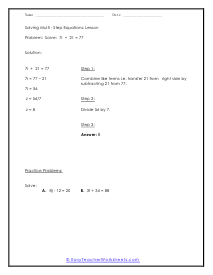
Solving Multi Step Equations Lesson
Follow the steps to learn how to solve the following problem: 7i + 21 = 77. This is a basic 2 step problem that you will get the hang off.

Solving Multi Step Equations Worksheet 1
Solve the following 10 equations that require all different types of steps.
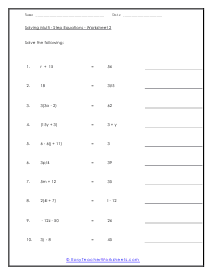

Solving Review
You will be given a fully completed example and then asked to solve a whole bunch of problems on your own.

Solving Multi Step Equations Quiz
Solve these 10 problems, then check your answers and score the results. This is a nice mix of problems some are simple and others are more difficult.
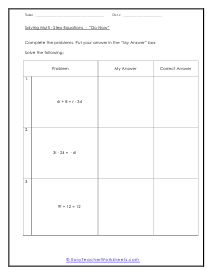
Do Now
This is the perfect worksheet to help you begin to understand where your class as a whole stands with this skill.

Solving Multi Step Equations Advanced Lesson
We look at a problem that often confuses students. When the variable we are looking to solve for is located in the numerator.
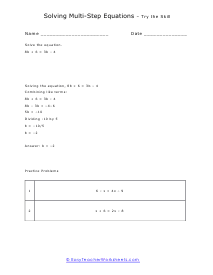
Try the Skill
We show you how to solve the equation 8b + 6 = 3b - 4, then practice the problems shown below.

10 Practice Problems
Solve these 10 equations. Using all that you know from what you have learned this far.
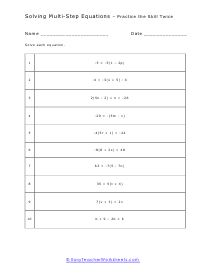
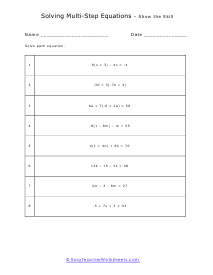
Solving Multi Steps Review
You will work on equations such as this: 8(x + 3) - 4x = -4. Remember the nature of integers to help you along with solving these problems.


Solving Equations (three step problems) Worksheet 1
All of these equations will require at least 3 steps to solve. Practice solving for y for each problem. Example: (32 ÷ y) - 1 = 1.13

3 Step Problems Worksheet 2
This is the second worksheet in the series. It will require students to push their equations in multiple directions to solve it.

3 Step Lesson and Practice Worksheet
The lesson shows you how to solve the algebraic equation 30 - x = 4x + 15, then practice with the problems provided.

Mixed Solving Multi Step Equations
There is a real mix of the types of problems that you will need to solve here. Some are single step and show may take up to five steps.
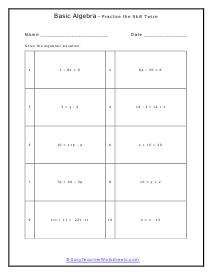
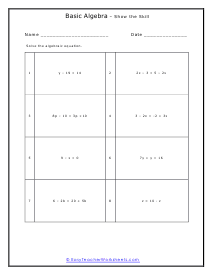
Solving Algebra Equations
Solve these 8 algebraic equations. They take up a bit more of space because they require more steps to solve than the previous worksheets.
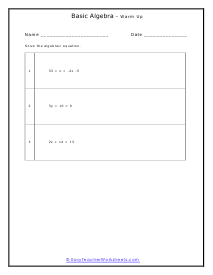
Equations Warm Up
This can be a helpful class review or introduction worksheet. Solve these 3 algebraic equations. Example: 33 + x = -2x - 5

Basic Algebra Lesson
This is really here for students that completely do not get the concept of moving one variable to the side. This will help those students that are behind. We thought it would make for a good resource for some teachers.
What are Multi-Step Algebraic Equations?
An algebraic equation is any mathematical statement showing that two expressions are equal. A multi-step algebraic equation is an algebraic equation that takes two or more steps to solve.
Multi-step algebraic equations can involve addition, subtraction, division, and multiplication and may involve using different mathematical properties to solve.
Examples of Multi-step algebraic equations:
3x+10=5x+12
2y - 6 - 7y = 4
5a – 6 = 12a
5(3b - 6) = 324(2m−4) =16
10x - 10 + 3 = 50 - 5x
How to Solve Them
An algebraic equation is not solved until you have isolated the variable and found a value that verifies the equation. To solve such an equation, we use the properties of inverse operation when moving a number or variable to either side of the equal sign.
- Addition is invertible for subtraction
- Multiplication is invertible for division
Another thing to remember when solving such a question is the PEMDAS rule that shows the order of operations. The equation must be operated in a sequence of parenthesis, exponents, multiplication or division, then the addition or subtraction. The BODMAS rule is also important in the case, which states the order as Brackets Open, Division, Multiplication, Addition, then Subtraction.
Two-Step Equations
Let's see how to solve the following equation:
3x + 8 = 17
We need to first isolate the variable x and then solve to get a value:
3x = 17 – 8
3x = 9
x = 9/3
x = 3
This type of equation is referred to as a two-step equation because it takes two steps to solve. The first step is to invert the 8 to the other side, changing the addition to subtraction. The second step was to invert the 3 to the other side, changing the multiplication to division.
Equations with Variables on Both Sides
Let's see how to solve the following equation:
4 + 16x = 12x + 28
Again, we need to isolate the variable and then solve to get a value:
16 x – 12 x = 28 – 4
4x = 24
x = 24/4
x = 6
This equation took more than two steps to solve. First, we inverted 12x to the other side of the equal sign, changing the addition to subtraction. Secondly, we inverted 4 to the other side, changing the addition to subtraction. Third, we inverted the multiple 4 to the other side, changing the multiplication to a division.
Equations Using the Distributive Property
Let's see how to solve the following equation:
6(6x – 2) + 14= 50 + 12x
We first isolate the variable x then solve to get a value:
36x – 12 + 14 = 50 + 12x
36x + 2 = 50 + 12x
36x – 12x = 50 – 2
24x = 48
x = 48/24
x = 2


